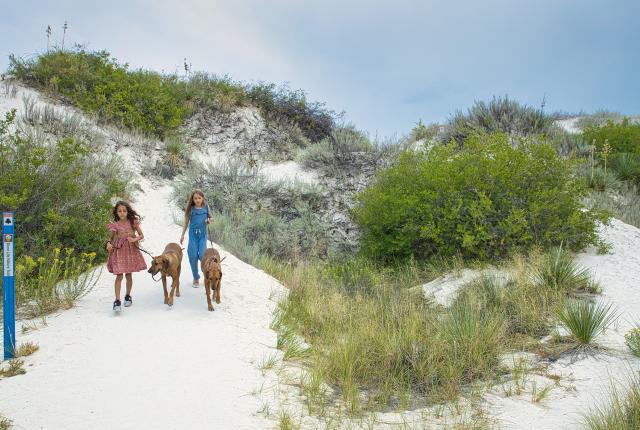Trails can be on sand or a boardwalk—but dogs must be leashed.
WHITE SANDS IN SOME WAYS a pathless place. Visitors are welcome to walk over any stretch of bare sand dunes. But these three hikes can help you break from the crowds and pique your curiosity at the strange features of the dunes, whether it’s a chance to learn a new wildflower or to consider what it takes for plants and animals to survive in this unique and intense environment.
Interdune Boardwalk
This elevated, stroller- and wheelchair-accessible boardwalk, less than a half mile long, traces the boundary between the dunes and the Chihuahuan Desert scrublands. The landscape becomes whiter, with skunkbush sumac and hoary rosemary mint holding a few pedestals of higher sand in place. Signs lead the tour through the array of plants and animals that live in this diverse landscape, benches offer a chance for a break, and the walk culminates at a point with a view of the Sacramento Mountains, with their own visible layer of pale gypsum, just like the surrounding sand.
Dune Life Nature Trail
Meander up and over several dunes, along the crest, and through the scrub brush on this one-mile hike, following a course set by stakes and frequent interpretive signs. The blend of dunes and Chihuahuan Desert habitats makes for variable opportunities for wildlife. Those interpretive signs talk you through some of the wild residents—pallid bats, coyotes, kit foxes, roadrunners, and burrowing owls, most of which avoid the heat by coming out only at night. By day, you’re most likely to see the three white lizards endemic to the dunes: the bleached earless, little white whiptail, and fence lizards. A few small cottonwoods, hinting at the subterranean waterworks, offer a brief shady respite.
Backcountry Camping Trail
This lollipop two-mile loop takes off from near the Loop Drive juncture and heads west across the classic white dune field. Scramble up their faces, stroll their ridges, and then wander through the basins between dunes, spotted with purple sand verbena and soaptree yucca. The field is reset regularly by wind-sculpted ripples and, occasionally, rainstorms, which leave stipples in the firmer stretches of sand, so follow the route-mapping stakes to stay on track. You can see signs of nightly visitors in the form of footprints across the sand. Indications of the slow drift of the dunes themselves show in yucca buried to their needle tips. When overnight permits resume, intrepid campers can haul in a load for the evening and sleep nestled between the dunes, watching the sun turn ever bolder shades of pink as it moves toward the blue profiles of the San Andres Mountains, lining the western horizon.

Read More: Visiting White Sands National Park
Read More: How the Dunes at White Sands Shift Over Time
Read More: Prehistoric Footprint at White Sands Tell Rich Stories


